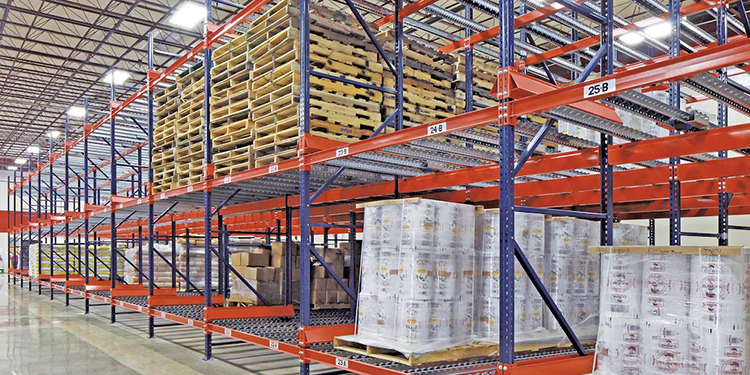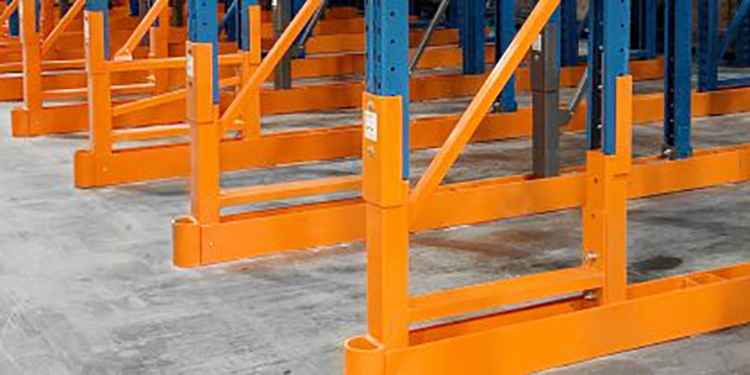Pallet flow rack systems—also known as gravity flow racking—are highly efficient storage solutions for facilities that manage high-volume, fast-moving inventory. Designed to work on a first-in/first-out (FIFO) basis, these systems incorporate inclined roller lanes that allow pallets to advance under the force of gravity.
However, even the most well-maintained pallet flow rack system can experience a jam, explained John Krummell, President and CEO of Advance Storage Products. The company is a member of the Rack Manufacturers Institute (RMI).
“Regardless of the cause, a stuck pallet in a live pallet flow system will disrupt operations. It can also pose a serious safety hazard if not handled properly,” he said. “By following the proper clearing techniques and emphasizing safety, an operation will minimize downtime, protect employees, and extend the life of the racking system.”
Here, Krummell shares several best practice techniques that can safely release a jammed pallet without risking injury or damaging the rack.
Why Pallets Get Stuck
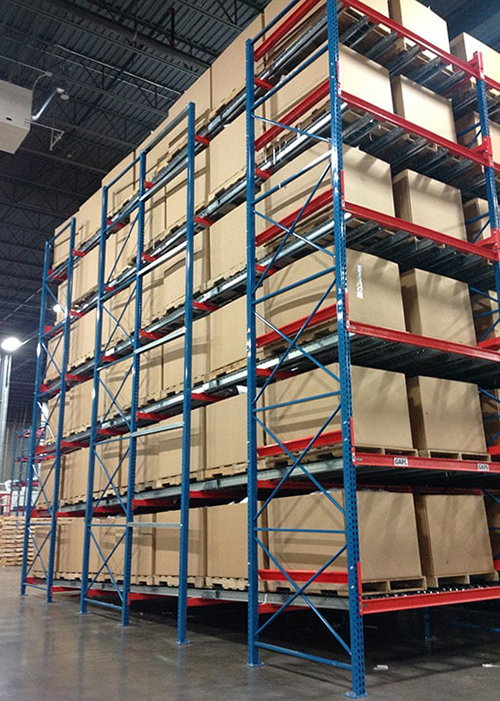 Before explaining how to clear a jammed pallet, it’s important to understand what can cause such an occurrence, noted Krummell.
Before explaining how to clear a jammed pallet, it’s important to understand what can cause such an occurrence, noted Krummell.
“Typically, it’s a pallet quality issue that causes a jam in a pallet flow rack,” he said. “That includes damage—such as broken or missing bottom boards—or a loose nail. The wheels in the roller tracks can easily snag a nail and cause the pallet to hang up. Likewise, poorly constructed pallets or ones with warped boards often jam in the lanes.”
Like all industrial steel storage rack, a pallet flow rack’s design accommodates a specific size and type of pallet. Putting a different type of pallet into the rack may, or may not, work.
“For example, a rack designed for a GMA pallet made of hardwood with a smooth rolling surface probably won’t work with disposable pine pallets. The wood is too soft, and the pallet flow rack’s wheels may actually dig into the wood as the load rests on them. That prevents the pallet from advancing,” Krummell explained.
Other causes include misaligned loading, debris in the lane, or environmental factors. Temperature shifts or humidity changes can affect the wood in the pallets, as well as the rolling of the flow rack’s wheels.
Safe Methods for Clearing Jammed Pallet Flow Rack
The key to safe recovery? Never allow anyone to enter a live pallet flow rack lane—ever. Instead, follow these safe and proven techniques.
1. Plugging with a Forklift
This is one of the safest and most effective methods, said Krummell.
- Position a forklift squarely at the discharge end of the lane.
- Lift the front pallet at the pick face approximately 1 inch off the rollers.
- Gently push it back into the load behind it by 3–4 inches.
- Back out slowly. If the stuck pallet begins to flow forward, the lane is now clear of the jam.
“If no movement occurs, place the pallet back and try another technique,” he added.
2. Force Loading with a Forklift
This approach leverages gravity to attempt to dislodge the jam.
- Load a new pallet from the charging end (back) of the lane.
- The new pallet may apply enough force to push the jammed one forward.
“Continue adding pallets until the jam clears or the lane reaches capacity,” Krummell said. “Be careful not to overload or damage the system, however.”
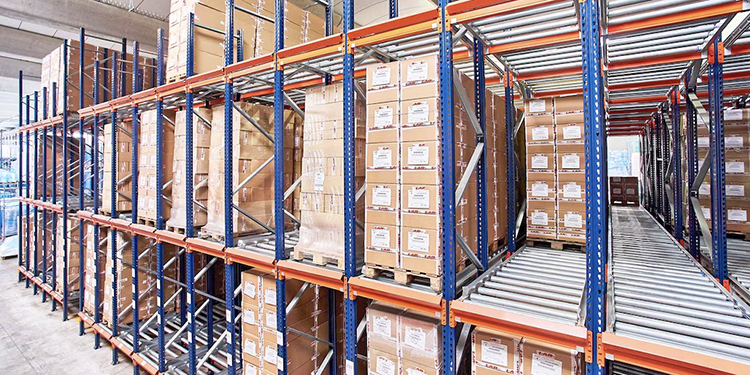
3. Adjacent Lane Clearing
A third option is more involved but can be effective if the first two approaches fail to clear the jam, Krummell advised.
- Remove the last pallet loaded into the jammed lane.
- Remove all pallets from the lane adjacent to the jammed one.
- With that lane now clear and tied-off to prevent access from either end, a trained associate can safely enter it. The associate must, however, wear the proper personal protective equipment—such as a harness and safety line that tethers them to a fixed point in case they fall.
- From the adjacent lane, the associate can observe or assist in clearing the jammed load from the side.
“I can’t emphasize the safety aspect of this enough,” he cautioned. “This method requires a secured work area and clear communication between personnel. Be extremely careful when using the adjacent lane clearing technique.”
4. Pick Face Loading with a Forklift
Sometimes loading the jammed lane from the front (discharge side) can force the stuck pallet loose.
- Load additional pallets onto the jammed lane from the pick face.
- This can push the stuck pallet back toward the load end and dislodge it.
“Always use an observer in the adjacent lane to monitor the movement of the pallet loads,” Krummell advised. “This is another instance where it’s important to avoid overexerting the system.”
Additional Safety Tips
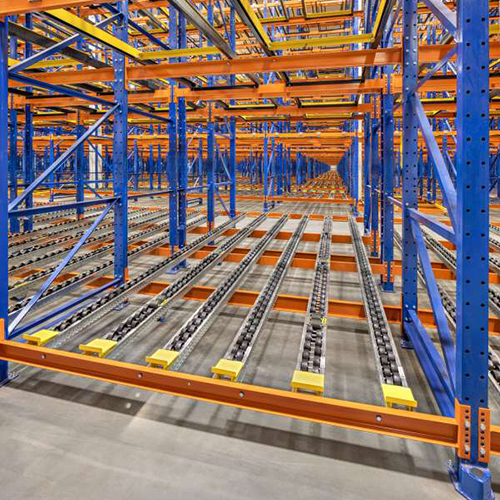 Safety should always be the top priority when dealing with pallet flow racks. Never allow anyone to climb into a live flow lane to reach a stuck pallet, as this poses a serious risk of injury. Instead, only trained forklift operators who are familiar with designated jam-clearing procedures should attempt to dislodge a load.
Safety should always be the top priority when dealing with pallet flow racks. Never allow anyone to climb into a live flow lane to reach a stuck pallet, as this poses a serious risk of injury. Instead, only trained forklift operators who are familiar with designated jam-clearing procedures should attempt to dislodge a load.
Before placing any pallets into the system, train associates to thoroughly inspect them for structural integrity. If an employee identifies damaged or substandard materials that are likely to cause a system jam, repalletize onto a different pallet, said Krummell.
Routine and well-documented racking inspections are also essential for identifying potential issues before they become serious problems. If pallet jams occur frequently, it’s important to consult your racking supplier or engineer, as the issue may stem from improper pallet quality or size.
“The system’s design may no longer meet the needs of the operation or the products and pallets it’s handling,” he added. “It may be time to take a look at the system with the original manufacturer and discuss modifying or replacing the system to meet evolving business needs.”
Learn More About Rack System Safety
Want more guidelines for the safe use of storage racks? Purchase RMI’s publications “Considerations for the Planning and Use of Industrial Steel Storage Racks” and “Guideline for the Assessment and Repair or Replacement of Damaged Rack.”
